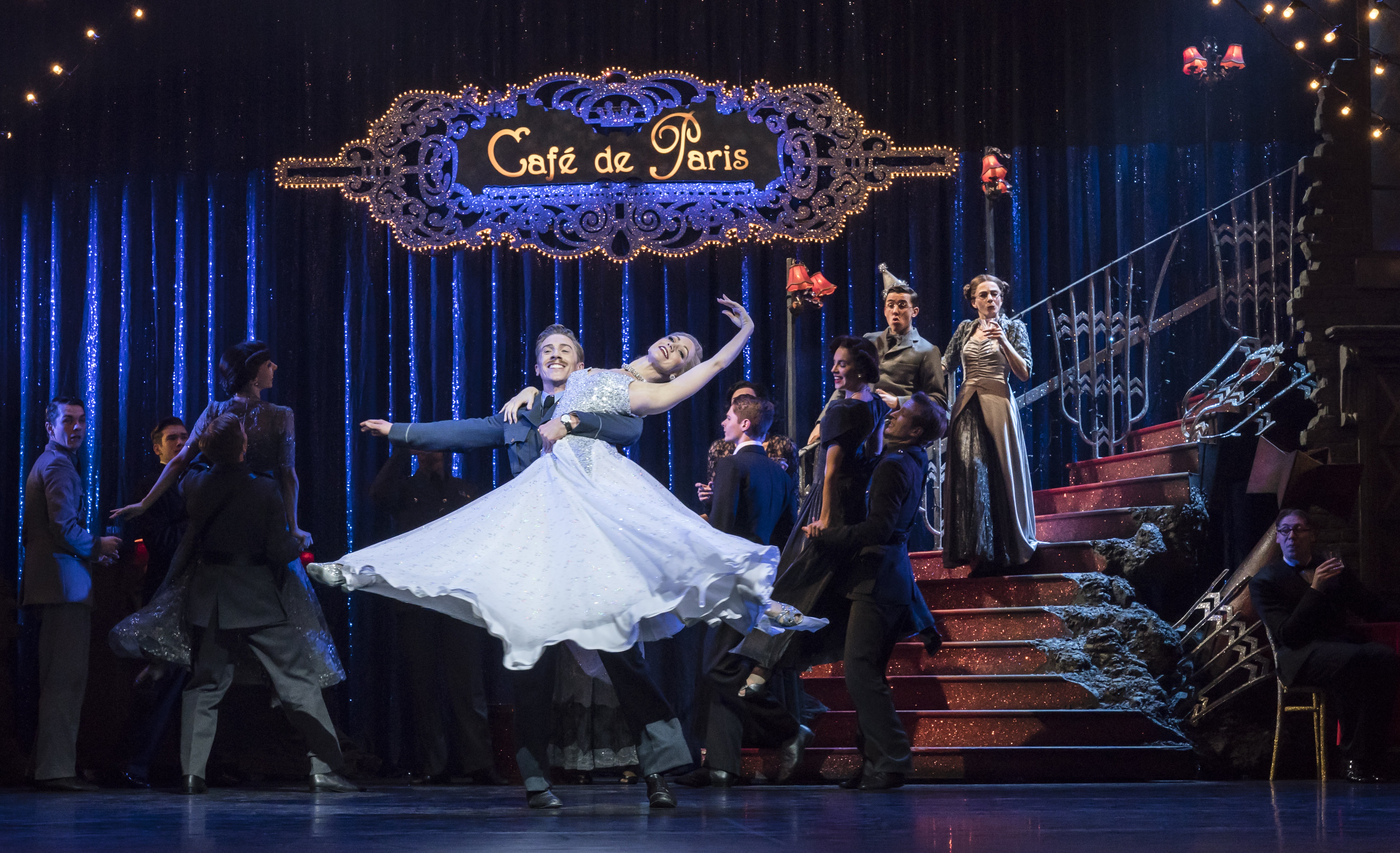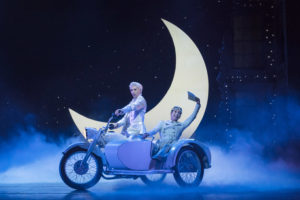Don’t walk into the Kennedy Center Opera House expecting a Disney-esque, happily-ever-after retelling of the evergreen fairytale Cinderella. British director/choreographer Matthew Bourne has spent his career re-inventing the classics—from his homoerotic, male-centric Swan Lake to his smart dance-theater take on Edward Scissorhands, to his theatricalized retelling of the Ur ballet film, The Red Shoes, seen in 2018 at the Kennedy Center. For Cinderella he sets the tale of a beleaguered orphan and her dream for a prince charming amid the destruction and mayhem of World War II’s London Blitz.

While a glamorous ball of sorts occurs in Act II, when plain-Jane Cinderella is transformed into a blonde starlet, think twice before taking any young, princess-loving kids to this one. It’s a decidedly dark – and long – evening, clocking in at two hours and 45 minutes. Sirens pierce the Prokofiev score, which itself is “enhanced” or pumped up into a feverish pre-recorded soundscape accompanied by an anxiety-inducing rumble of tanks and jets, which hang in the air even before the curtain even rises. And those stepsisters and stepmother aren’t just mean, they’re malevolent. And the added trio of stepbrothers are even worse – one is a fetishist and secret pedophile who spends his time on stage ogling people while wearing a long raincoat. This Cinderella is no sweet bedtime story for the little ones.
That said, there’s much to admire in Bourne’s full-blown production, from wow-inducing sets and chic 1940s costumes and hairstyles by long-time Bourne collaborator Lez Brotherston, to Paul Groothuis’s aural universe that melds the musical score with sounds of war with a movie soundtrack flair. And Neil Austin’s place-defining lighting lends depth and shadow to war-torn London and an other-worldly, halo-like glow to the Fairy Godmother character, here known as the Angel and danced by a man—something Bourne often does in his works, reversing gender roles (see his Swan Lake).
Unexpectedly, the storyline feels overly complicated for such a well-known tale. Act I, of course, introduces Cinderella, along with her emasculated, wheelchair-using father; her controlling, hard-drinking stepmother and those nasty stepsisters and unsavory and annoying stepbrothers. Dressed in black, white and shades of gray in homage to old movies—Bourne is an admitted cinephile—the Act I clan bullies and ignores Cinderella. But she’s not without spunk as danced by longtime Bourne leading lady Ashley Shaw. We see little moments of playfulness: donning that Joan Crawford-esque stepmother’s fur and sashaying around behind her back and later dancing with her stepbrother’s tailor mannequin, who transforms into her handsome, if wooden, prince, an RAF pilot. And no wonder she yearns for escape. Who wouldn’t with those stepsisters with their louche stares, a stepbrother who wavers between a foot fetishist and a pedophile who can’t keep his eyes—or hands—off Cinderella, and her alcoholic stepmother, Sybil, who might as well pull a full Joan Crawford and threaten Cinderella with a wire hanger.
The ingenue meets a wounded pilot named Harry (Andrew Monaghan) when he wanders, bandaged, into Act I. But why? While at the house he’s clearly befuddled and leaves behind his hat, which Cinderella packs into a suitcase along with her glittery silver slippers. She takes agency over her life, which doesn’t feel like magic from her Angel, and runs away—straight into London’s bombed-out streets.
Act II’s glitzy dance hall, Café de Paris, is initially a decimated shell of the once-lively nightclub. A scenic transformation brings it back to full life. Is it a dream or a spell from the Angel, clad in a sleek silvery suit? Bourne plays with the club dances, giving his company fitting but fun motifs as they pair off: a little moment of fisticuffs as if partners ready for a sparring match, before the women dip and fall effortlessly to the floor. When Cinderella makes her grandiose entrance, dancer/actress Ashley Shaw has been completely transformed—offstage, alas, with no magical puffs from the Angel—the mousy brown-hair, gray-clad girl swoons as a bleached blond Hollywood starlet, her shimmery white gown blinds against the barren backdrop.

Act II’s the ball, part fevered dream, part nightmare, begins and ends with an air raid and its destruction. Is it a flashback, a story-in-a-story or a dream sequence? It’s hard to tell, and although the dancing displays verve and plenty of panache, the constant stream of motion lacks particularity. Bourne is best choreographically in smaller moments and little telling gestural phrases that define character. His large canvas movement melds into a wash of non-stop fanning legs, sweeping arms and swerving bodies, focusing more on traffic patterns than inventive steps. And his timeline and story leave frustrating gaps. The eye in this scene is often drawn to that brassy, louche stepmother, until, of course, all heads turn to Cinderella who waltzes to her heart’s content with a squad of military men literally lined up to spin her around.
She meets her “prince”— was he imagined in Act I?— RAF pilot Harry, and they sneak off, but the nightclub’s sparkle collapses. Their pas de deux takes place in a burned out shell of a building and unfortunately, choreographically indistinct, this intimate moment feels strained and rushed. The duet should pulse with passion as the principles embrace, break apart and rush to one another’s arms. Alas, this Romeo and Juliet-moment of deeply spiritual connection never comes, both Shaw and Monahan on opening night felt distance, lacking the necessary profound soul-merging feeling this moment demands.
Bourne continues Act III in a hospital where the wounded Cinderella finds her wounded prince, who undergoes electroshock therapy to cure his PTSD. The finale suggests a muted victory. Their reconnection, more of a meet-cute, tinged with hesitation and shyness that’s far more telling than the dreamlike dancing we earlier experienced. Later, in Paddington Station at the war’s end, couples reunite, soldiers depart and civilians wait for loved ones. Amid confetti and fireworks, Cinderella and Harry, now wearing glasses and ordinary street wear, have lost the glamour and mystique of their ordeal, real or imagined. Perhaps, the whole thing never happened and Act II was a dream or nightmare brought on by the Blitz, leaving Cinderella and her pilot to meet in the hospital. Here the Angel returns for his last look at the couple as they board a train for an ordinary-ever-after life.
Although not his strongest work, Bourne’s Cinderella will resonate for those who like the darker side of magical fairytales. And, like all of his New Adventures productions, the greater experience, this time featuring surround sound, 1940s newsreels, stunning scenery, state-of-the-art projections, lighting, and stagecraft, provides enough spectacle to satisfy theatergoers, even as they puzzle through the timeline and narrative gaps during both intermissions. Bourne’s Cinderella journeys into some of the bleakest moments in his London hometown’s contemporary history. Beyond the Allied victory lies a smaller, plainer win: somehow Cinderella and Harry, her wounded pilot, found one another amid death and destruction. Perhaps that’s the real fairytale, that in spite of war, life—and love—can go on after all.
Running Time: Two hours and 45 minutes, with two intermissions.
Cinderella plays through January 20, 2019 at The John F. Kennedy Center for the Performing Arts Opera House – 2700 F Street NW in Washington, DC. For tickets, call (202) 467-4600 or go online.




